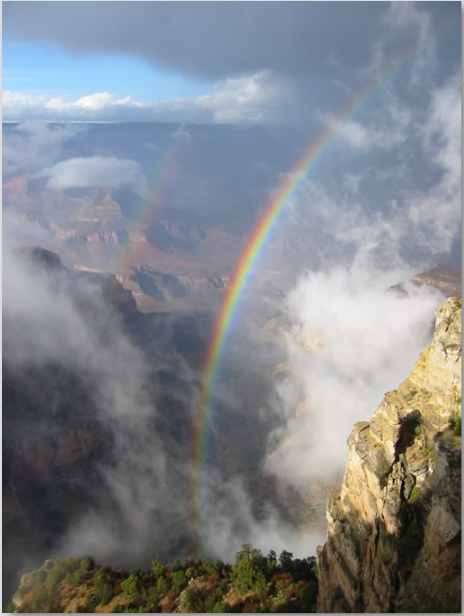Grand Canyon Rainbow
Grand Canyon Rainbow: A Spectacular Natural Phenomenon
The Grand Canyon is renowned for its awe-inspiring beauty and breathtaking landscapes. But did you know that this majestic wonder of nature can also create mesmerizing rainbows? Yes, the Grand Canyon is not only a sight to behold during the day, but it can also dazzle visitors with its vibrant rainbows during certain weather conditions. In this article, we will explore the phenomenon of Grand Canyon rainbows and delve into the science behind their formation.
The Formation of Grand Canyon Rainbows
Rainbows are optical phenomena that occur when sunlight is refracted, reflected, and dispersed by water droplets in the atmosphere. The Grand Canyon provides a unique setting for the formation of rainbows due to its immense size and the presence of water particles in the air. When rain showers pass through the canyon, the sunlight interacts with the water droplets, resulting in the creation of stunning rainbows.
Primary and Secondary Bows
Grand Canyon rainbows often display both primary and secondary bows. The primary bow is the more commonly observed rainbow and appears as a semi-circular arc with red on the outer edge and violet on the inner edge. This bow is formed by a single reflection and refraction of sunlight within the water droplets. The secondary bow, on the other hand, is less frequently seen and appears as a fainter arc above the primary bow. It is formed by two internal reflections and refractions of sunlight within the droplets.
The Role of Sunlight Angle
The angle of the sun plays a crucial role in the visibility and intensity of Grand Canyon rainbows. For a rainbow to form, the sun must be behind the observer, while rain or moisture is present in the air ahead. The lower the sun is in the sky, the higher the rainbow will appear. This means that during sunrise or sunset, when the sun is near the horizon, rainbows can stretch across the vast expanse of the Grand Canyon, creating a truly magical spectacle.
Spectral Colors of Grand Canyon Rainbows
Rainbows are renowned for their vibrant colors, and Grand Canyon rainbows are no exception. The primary bow typically displays a range of colors, including red, orange, yellow, green, blue, indigo, and violet. These colors are a result of the dispersion of sunlight as it passes through the water droplets. Each color has a specific wavelength, and when combined, they create the stunning display of a rainbow. The secondary bow appears less saturated and often has its colors reversed compared to the primary bow.
Atmospheric Conditions and Rainbows
The formation of rainbows is dependent on specific atmospheric conditions. For Grand Canyon rainbows to occur, there must be a combination of sunlight, rain showers or mist, and the presence of suspended water droplets in the air. The size of the water droplets also affects the visibility and intensity of the rainbow. Smaller droplets tend to produce more vibrant and well-defined rainbows, while larger droplets can result in fainter and less distinct bows.
Capturing the Grand Canyon Rainbow
Photographing a Grand Canyon rainbow can be a challenge due to the ever-changing weather conditions and the vastness of the canyon itself. However, with patience and a bit of luck, photographers can capture truly breathtaking images. The contrast between the vibrant rainbow and the rugged canyon walls creates a striking visual composition that can be a photographer's dream.
Beyond Rainbows: Other Atmospheric Optics at the Grand Canyon
While rainbows are undoubtedly a captivating sight at the Grand Canyon, they are just one of many atmospheric optics phenomena that can be experienced in this natural wonder. Visitors may also have the opportunity to witness other enchanting occurrences such as halos, glories, and iridescent clouds. These phenomena arise from different interactions between sunlight and atmospheric particles, creating a symphony of colors and patterns in the sky.
The Grand Canyon: A Natural Wonder
The Grand Canyon is a testament to the beauty and power of nature. Its towering cliffs, deep canyons, and now, its vibrant rainbows, make it a must-visit destination for nature enthusiasts and photographers alike. Whether you are fortunate enough to witness a rainbow stretching across the canyon or simply marvel at the sheer magnificence of this geological masterpiece, the Grand Canyon will leave an indelible mark on your memory.
Conclusion
Grand Canyon rainbows are a mesmerizing natural phenomenon that adds another layer of beauty to this already awe-inspiring landscape. From the primary and secondary bows to the role of sunlight angle and atmospheric conditions, understanding the science behind these rainbows enhances our appreciation for the wonders of nature. So, if you find yourself exploring the Grand Canyon, keep an eye out for those elusive rainbows and prepare to be captivated by their ethereal beauty.

Grand Canyon Rainbows and Storm
Primary and secondary bows arc into the canyon.
Kevin Porter of Guelph, Ontario, Canada, pictured them from the canyon rim after hiking up from the bottom through torrential rain.
©Kevin Porter, shown with permission.
Note: this article has been automatically converted from the old site and may not appear as intended. You can find the original article here.
Reference Atmospheric Optics
If you use any of the definitions, information, or data presented on Atmospheric Optics, please copy the link or reference below to properly credit us as the reference source. Thank you!
-
<a href="https://atoptics.co.uk/blog/grand-canyon-rainbow-2/">Grand Canyon Rainbow</a>
-
"Grand Canyon Rainbow". Atmospheric Optics. Accessed on December 22, 2024. https://atoptics.co.uk/blog/grand-canyon-rainbow-2/.
-
"Grand Canyon Rainbow". Atmospheric Optics, https://atoptics.co.uk/blog/grand-canyon-rainbow-2/. Accessed 22 December, 2024
-
Grand Canyon Rainbow. Atmospheric Optics. Retrieved from https://atoptics.co.uk/blog/grand-canyon-rainbow-2/.